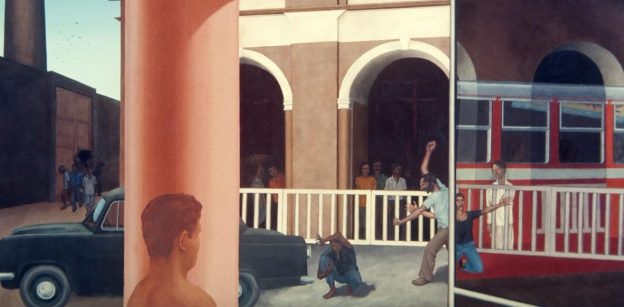Spanning the late 19th century until the present day, the narrative of modern and contemporary art in India is characterised by shifting socio-political climates and reflections on the subcontinent’s past. This Short Course will give you insight into this complex history and introduce you to examples of major art schools and movements across the country through a series of engaging videos and illustrated texts. These lessons delve into topics such as the emergence of abstraction, the rise of artist collectives and the history of photography. Our approach attempts to be inclusive by thinking beyond cosmopolitan centres, and shedding light on artists who have otherwise been marginalised.
Through this Course, you will:
- Learn about key artists, artworks and exhibitions, and how they have responded to and engaged with both regional and global art contexts.
- Develop a wider appreciation for how the past shapes the present in the context of art.
- Understand how a single artwork can be interpreted in multiple ways.
- Gain insight into important historical events and contemporary developments through the help of visual mediums.
- Recognise how artists can chronicle our times by reflecting upon ideas and themes that sometimes transcend the potential of the written word.
- Understand the basic functioning of art institutions.
Who wrote the Course?
This Course is authored by Dr Beth Citron, Curator of Modern and Contemporary Asian and Asian Diaspora Art at the Asia Society Museum in New York. A 2019 recipient of the Asian Cultural Council Fellowship for research on the curatorial history of modernist art from India, she was the Founding Curator of Modern and Contemporary Art at the Rubin Museum of Art until October 2019. She holds a PhD in Art History from the University of Pennsylvania and has taught in South Asian contexts as well as at the Art History Department at New York University, where she earned her BA in Fine Arts.
The Course has been edited and produced by the research and editorial team of the MAP Academy.
Who is the Course for?
This Course is open to all, irrespective of background.
Enrolment
This Course is free of charge, and you can enrol today by registering through the link above.
How to navigate this Course?
- This Course is divided into multiple lessons that comprise a number of topics presented in the form of short videos or illustrated texts.
- It is recommended that you go through the Course in sequential order.
- As you go through the Course, you must complete a quiz at the end of each Lesson to check your progress and continue.
- At any point, you are welcome to participate in the Course Discussion Forum, where you can meet and engage with a community of online learners.
- Once you have registered, you can either click the ‘Start’ button at the top of this page, or the first Lesson below to begin.
- Using your login credentials, you should be able to re-enter the Course at any point through your computer, phone or tablet, and continue from where you left off.
Notes on Content:
- The field of modern and contemporary Indian art has been shaped by diverse artists, institutions and scholars, and given the scope of this Short Course, it has not been possible to be all-inclusive. That said, our hope is for this to serve as an empowering entry point through which anyone can deepen their engagement.
- Modern and contemporary art has emerged in unique ways across the broader South Asian region, despite some overlapping timelines, interactions and shared experiences. Therefore, we have chosen a country-wise approach to this subject, and will be launching courses on modern and contemporary art from other nations in the region in the future.
- Throughout the history of art — in South Asia and beyond — unclothed human bodies have been depicted frequently, and such imagery has often been the target of controversy or censorship. In this Course, the representation of nude figures is used for educational purposes only. Our aim to discuss formal artistic questions as well as complex themes surrounding ideas of the gaze, power, socio-cultural norms and individual expression. These are not intended to cause offence on any grounds.
- The political boundaries displayed in maps within the Course can be a subject of ongoing disputes or contestation, based on complex historical, cultural and geopolitical factors. The maps included are based on archival materials, and are only meant to serve as visual aids, to enhance the learning experience, provide geographical context and facilitate comprehension of particular artistic narratives. They do not endorse, promote or invalidate any specific political or territorial claims.
Partners
We would like to thank Terrain.art, a partner on this project.

Supporters
This Course has also benefitted from support of the Art & Photography Foundation, the Rural India Support Trust and the Infosys Foundation.


